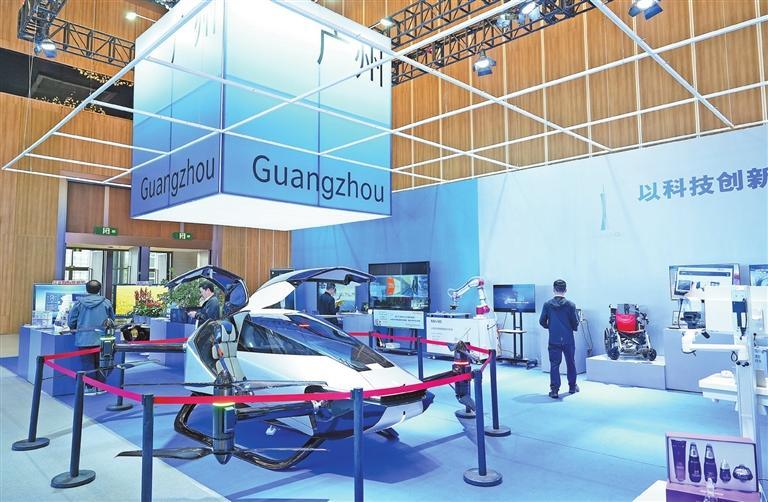
A flying car showcased at an exhibition on the sidelines of the Guangdong Provincial High-quality Development Conference in Shenzhen yesterday. A total of 662 innovative products from 305 companies were displayed at the exhibition, highlighting achievements in the integrated development of industries and technologies.
As the vanguard and experimental area of China's reform and opening up, Guangdong has long been one of the country's most open, dynamic, and innovative regions.
President Xi Jinping, during an inspection trip to Guangdong in April last year, urged the province to focus on high-quality development as its primary task and to forge a new development pattern as its strategic mission. He also envisions the province achieving greater self-reliance and strength in science and technology and becoming a trailblazer on the Chinese path to modernization.
Huang Kunming, Party chief of Guangdong, said that Guangdong has a large population, limited resources, and a heavy burden to balance and coordinate development (resources) during a grand conference on high-quality development in the provincial capital of Guangzhou on Jan. 28 last year.
He said it's unwise to compete with Guangdong's global counterparts on cheap land supply, product price, and labor cost. The only way to respond to external competition and uncertainties, he said, was to modernize and aim for quality.
"High-quality development is an inevitable path for Guangdong to achieve modernization," he declared.
By prioritizing innovation-driven and eco-friendly growth through bolstering support for tech-intensive industries and fostering new growth momentum, Guangdong has been playing a prominent role in the country's pursuit of high-quality development.
In 2023, Guangdong became the first province in the country to generate a gross domestic product (GDP) exceeding 13 trillion yuan (US$1.83 trillion). The province has maintained the highest GDP in the country for 35 consecutive years. The southern China economic powerhouse saw its economy grow 4.8% year on year to hit 13.57 trillion yuan in 2023, which accounted for about one-tenth of the national GDP. Comparatively, there are only about 10 countries in the world that have a higher GDP.
It is widely agreed that the focus of high-quality development lies in the manufacturing industry. Wang Weizhong, governor of Guangdong, said that to achieve its goal of seeking high-quality growth, Guangdong is focusing on high-tech industries, such as digital information, new materials, and renewable energy, while simultaneously maintaining the key role of its manufacturing sector.
Official figures show that the added value of the manufacturing sector in Guangdong accounted for 32.7% of the province's GDP, underlining Guangdong's status as a crucial global manufacturing hub. The province has some of the best industrial and supply chains in the world.
With more than 71,000 industrial firms with an annual revenue from principal business exceeding 20 million yuan and more than 75,000 high-tech firms, Guangdong boasts the country's largest number of industrial firms. In 2023, the province added 47 national industrial manufacturing leaders to bring the total number to 132, making up 11% of the nation's total.
Guangdong also leads the nation with 1,528 "little giant" industrial firms, adding 652 last year. Little giants are small and medium-sized firms that focus on a niche market, master key technologies, possess a strong capacity for innovation, and command a large market share. These firms possess special products and know-how in strategic sectors like semiconductors, advanced manufacturing, energy, and critical minerals. These specialized and sophisticated firms are not only an important driver of economic growth, but are also crucial to improving the stability and competitiveness of the industrial supply chain.
The large group of industrial firms are the driving forces behind Guangdong's shift from labor-intensive and low-value-added goods to tech-intensive and high-value-added products. They are critical to efforts to climb the industrial value chains and help drive the province's manufacturing industry toward higher-end, more intelligent, and greener development.
Guangdong's strength in advanced manufacturing is best seen in the green transformation in its foreign trade landscape, which has seen the province's traditional export categories, such as clothing, home appliances, and furniture, once the pillars of its exports, make way for high-tech exports in the new energy sector.
Combined exports of electric vehicles, lithium-ion batteries, and solar cells (the building blocks of solar panels), now widely known as the "new three" products, jumped 33.70% year on year in 2023, Wen Zhencai, deputy director of Guangdong Customs, said at a news conference in Guangzhou in January. The strong performance of the "new three" products contrasts with an overall 0.3% year-on-year increase in Guangdong's foreign trade and comes amid an unstable global economic recovery, weakened external demand, and sluggish growth in major economies, according to Wen.
Guangdong led the country in auto production for the seventh year in a row in 2023, churning out about 17% of the country's cars. Almost half of the 5.19 million cars, or 2.53 million units, made in Guangdong last year were new energy vehicles (NEVs), which consists of electric cars and plug-in hybrids. One out of every four NEVs in the country is currently manufactured in the province.
With a relatively complete industrial chain, Guangdong is home to some of China's most well-known electric vehicle brands including BYD, Xpeng, and GAC Aion. Shenzhen-based BYD, the world's largest electric-car maker, delivered 3.02 million electric and plug-in hybrid vehicles in 2023, surpassing Tesla's production of 1.84 million purely battery-powered cars.
The rapidly developing NEV sector has become a major growth engine of Guangdong's manufacturing sector and a bright spot of the province's economic development. Guangdong's automobile industry is expected to rake in operational income of over 1.35 trillion yuan (US$189.2 billion) by 2025, with NEV production accounting for more than half of total vehicle production, according to a provincial plan. Guangdong also intends to upgrade the industry chains of key NEV components including motors, batteries, electronic controls, and vehicle-grade chips in the years to come, an annual government work report delivered recently shows.



